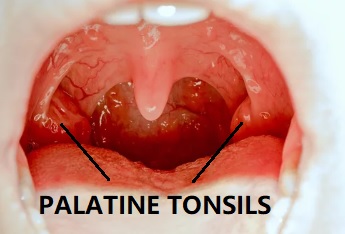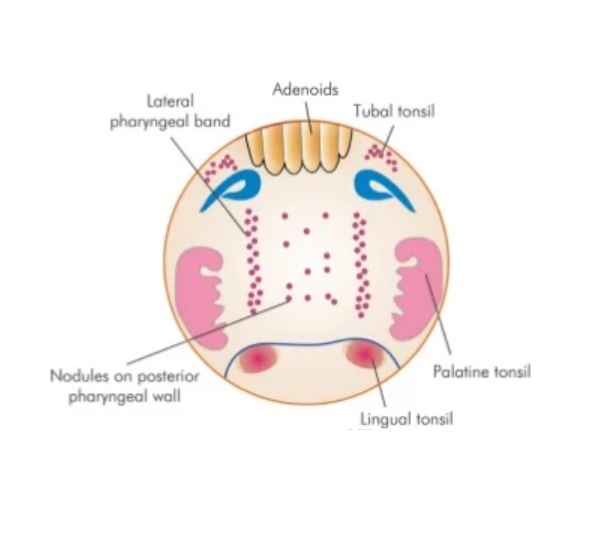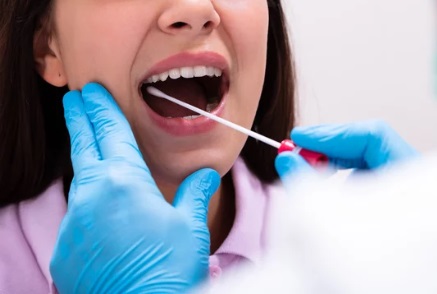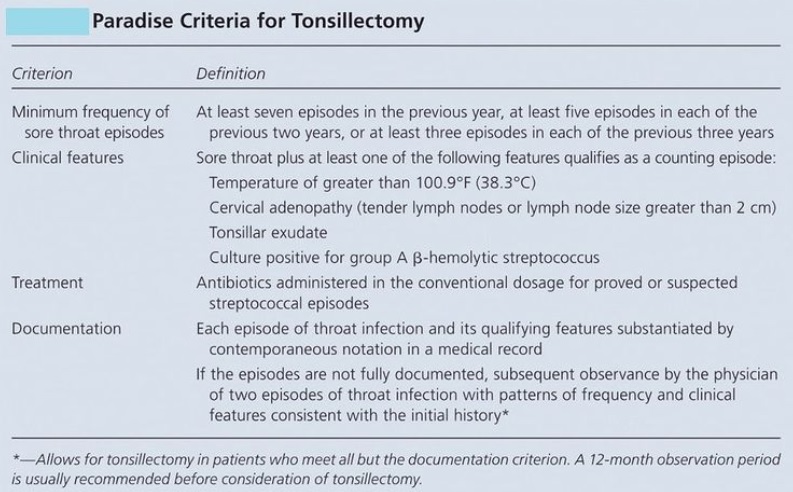The tonsils are lymphoid tissue at the back of your throat.
They are part of the immune system, which helps your body fight infection.

What is Tonsillitis?
Tonsillitis is an infection of the tonsils that is caused by bacteria or a virus. Tonsillitis can typically last from a few days up to a couple of weeks.
Tonsillitis caused by a virus goes away on its own, whereas tonsillitis caused by the bacteria is treated with antibiotics.
You and your doctor may consider surgery to remove the tonsils (tonsillectomy) if you have serious complications or repeat infections.
Let’s talk about Waldeyer’s tonsillar ring.
In the pharynx at the back of the throat, there is a ring of lymphoid tissue.
There are six areas of lymphoid tissue in Waldeyer’s ring, which include —
- Adenoids,
- Tubal tonsils,
- Palatine tonsils, and
- The Lingual tonsil.
The palatine tonsils are the ones typically infected and enlarged in tonsillitis. These are the tonsils on either side at the back of the throat.

Types of Tonsillitis
1. Acute Tonsillitis: It is of rapid onset and is usually caused by bacterial or viral infection.
2. Chronic Tonsillitis: It is of long duration if untreated and usually caused by bacterial infection.
Symptoms of Tonsillitis in Adults
Generally, the symptoms are the same for both children and adults.
Symptoms may include:
- Sore throat
- Pain while swallowing
- Fever
- Headache
- Swollen glands
- Feeling unwell
- Scratchy voice
- Cough
- Enlarged lymph nodes in the neck
- Red, inflamed, and enlarged tonsils
- Dysphagia
- Myalgia (muscle ache)
- Referred pain in ears (aka Referred Otalgia)
- Halitosis (bad breath)
- Dry mouth
- Snoring and disturbed sleep
Causes of Tonsillitis
a) VIRAL INFECTION
The most common cause of tonsillitis is a viral infection. The virus causes infections such as the common cold and flu.
EBV virus causes Infectious mononucleosis which is similar to throat infection and is also known as the kissing disease.
Some of the common viruses that cause tonsillitis are:
- Adenovirus.
- Influenza virus.
- Epstein-Barr virus.
- Parainfluenza virus.
- Enterovirus.
- Herpes simplex virus.
b) BACTERIAL INFECTION
The most common cause of bacterial tonsillitis is Group A Streptococcus or streptococcus pyogenes.
This can be effectively treated with Penicillin V.
The second most common bacterial cause of tonsillitis is Streptococcus Pneumoniae.
Other causes are Haemophilus Influenzae, Moraxella catarrhalis, and Staphylococcus aureus.
Diagnosis of Adult Tonsillitis
1. History Collection: The doctor will ask about the present, past, medical, and family history.
2. Physical Examination: The doctor will check the patient’s tonsils by opening the mouth. White patches may be seen if pus is formed there or an abscess is present.
3. Throat Swab Culture: Saliva is collected from the throat and cultured to detect, which microorganism is present (bacteria or virus).

Complications of tonsillitis:
Let’s discuss the complications of bacterial tonsillitis and these include:
- Peritonsillar abscess (quinsy).
- Otitis media if the infection spreads up to the middle ear.
- Scarlet fever.
- Rheumatic fever.
- Post-streptococcal glomerulonephritis.
- Post-streptococcal reactive arthritis.
Management of tonsillitis:
A) Medical Management:
Antibiotics: If the cause of tonsillitis is bacterial infection, then antibiotics will be given to the patient. Penicillin is commonly used. If the patient is allergic to penicillin, then erythromycin or amoxicillin may be prescribed accordingly by the doctor.
Analgesics: In case of tonsillitis, Ibuprofen may be prescribed for relieving pain by the doctor.
B) Surgical Management:
Tonsillectomy: Tonsillectomy is performed to remove tonsils when infection or inflammation recurs frequently and the patient may have difficulty in speech, swallowing, and respiration.
Tonsillitis is very rarely serious and does not often need more than over-the-counter pain killers and rest.
A tonsillectomy is a surgery to remove the tonsils. Sometimes the adenoids are also removed during the same surgery. The tonsils and adenoids are placed almost adjacent to each other. The surgery is done through your mouth. You may be able to go back to work or your usual routine in 1 to 2 weeks.
After surgery, you may snore or breathe through your mouth at night. This usually gets better 1 to 2 weeks after surgery. Mouth breathing can make your mouth and throat dry or sore. Place a humidifier by your bed when you sleep. This may make it easier for you to breathe. It’s common for people to lose weight after this surgery. That’s because it can hurt to swallow food at first. As long as you drink plenty of liquids, this is okay. You will probably gain the weight back when you can eat normally again.
Most adults have a lot of throat pain for 1 to 2 weeks or longer. The pain may get worse before it gets better. The pain in your throat can also make your ears hurt. You may have good days and bad days. Most people find that they have the most pain in the first 8 days. You probably will feel tired for 1 to 2 weeks. You may have bad breath for up to 2 weeks.
General instructions:
- You may notice that your bowel movements are not regular right after your surgery. This is common. Try to avoid constipation and straining with bowel movements. You may want to take a fiber supplement every day. If you have not had a bowel movement after a couple of days, ask your doctor about taking a mild laxative.
- Drink plenty of fluids to avoid becoming dehydrated.
- If it is painful to swallow, start out with Popsicles, ice cream, or cold or room-temperature drinks. Do not eat or drink red food items, such as red juice or red Jell-O. The color may make you think you are bleeding.
- Avoid hot drinks, soda pop, orange or tomato juice, and other acidic foods that can sting the throat. These may make throat pain worse and cause bleeding.
- For 2 weeks, choose soft foods like pudding, yogurt, canned or cooked fruit, scrambled eggs, and mashed potatoes.
- Avoid eating hard or scratchy foods like chips or raw vegetables.
INDICATIONS FOR TONSILLECTOMY:
- Recurrent infections.
- Chronic tonsillitis.
- Peritonsillar abscess.
- Obstructive symptoms.
- Suspected malignancy.
PARADISE CRITERIA FOR TONSILLECTOMY is followed worldwide

How can you care for yourself at home?
Home care can help with a sore throat and other symptoms. Here are some things you can do to help yourself feel better.
- Gargle with warm saltwater.
This helps reduce swelling and relieve discomfort. Gargle once an hour with 1 teaspoon of salt mixed in 8 fluid ounces of warm water.
- Over the counter painkillers such as Ibuprofen, Aceclofenac, Paracetamol, or naproxen can be taken. Be safe with medicines. Read and follow all instructions on the label.
- Be careful when taking over-the-counter cold or flu medicines at the same time. Many of these medicines already have Paracetamol. Read the labels to make sure that you are not taking more than the recommended dose.
- Try lozenges or an over-the-counter throat spray to relieve throat pain.
- Drink plenty of fluids. Fluids may help soothe an irritated throat. Drink warm liquids (in moderation). These include tea, soup, etc.
- Do not smoke, and avoid passive smoking. Smoking can make tonsillitis worse. If you need help quitting, talk to your doctor about stop-smoking programs and medicines. These can increase your chances of quitting for good.
- Use a vaporizer or humidifier to add moisture to your bedroom.
- If your doctor prescribed antibiotics, take them as directed. Do not stop taking them just because you feel better. You need to take the full course of antibiotics.
- Get plenty of rest.
When should you call for help?
Call your doctor or seek immediate medical care if:
- Your pain gets worse on one side of your throat.
- You have a new or higher fever.
- You notice changes in your voice.
- You have trouble opening your mouth.
- You have any trouble breathing.
- You have much more trouble swallowing.
- You have a fever with a stiff neck or a severe headache.
- You are sensitive to light or feel very sleepy or confused.
Watch closely for changes in your health, and be sure to contact your doctor if you do not get better after 2-3 days of starting antibiotics.
THANK YOU
MEDICAL ADVICE DISCLAIMER:
This blog including information, content, references, and opinions is for informational purposes only.
The Author does not provide any medical advice on this platform.
Viewing, accessing, or reading this blog does not establish any doctor-patient relationship.
The information provided in this blog does not replace the services and opinions of a qualified medical professional who examines you and then prescribes medicines.
And if you have any questions of medical nature, please refer to your doctor or the qualified medical personnel for evaluation and management at a clinic/hospital near you.
The content provided in this blog represents the Author’s own interpretation of research articles.
